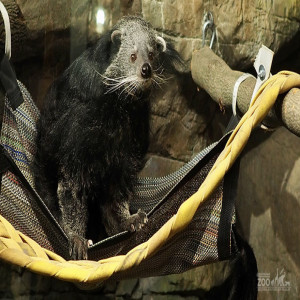 Binturongs are predatory animals that live in the tropical rain forests of Southeast Asia. In appearance they look like a type of raccoon or coati and are often considered as smaller relatives ot the bear family. The binturong is also known as the ”bearcat.” In fact, they do not belong to the bear family, they are viverrids (group of animals including civets and genets). Their body size ranges from 2–3 feet with their tail being as long as their body. They weigh between 24–79 pounds with females being heavier than males. The bushy and prehensile tail is thick at the root, gradually tapering, and curls inward at the tip. The muzzle is short and pointed, somewhat turned up at the nose and is covered with bristly hairs, brown at the points.The eyes are large and black. Ears are short rounded, edged with white, and terminating with tufts of black hair. The binturong is long and heavy with short, stout legs. It has a thick coat of coarse black hair. The feet are five-toed with large strong claws, bare soles and the whole length applied to the ground (hind feet longer than the fore ones). Some say they smell like popcorn due to a compound found in their urine that is also what gives popcorn its distinctive smell. Their numbers have declined by about 30% since the 1980s and are assessed as Vulnerable.
Binturongs are predatory animals that live in the tropical rain forests of Southeast Asia. In appearance they look like a type of raccoon or coati and are often considered as smaller relatives ot the bear family. The binturong is also known as the ”bearcat.” In fact, they do not belong to the bear family, they are viverrids (group of animals including civets and genets). Their body size ranges from 2–3 feet with their tail being as long as their body. They weigh between 24–79 pounds with females being heavier than males. The bushy and prehensile tail is thick at the root, gradually tapering, and curls inward at the tip. The muzzle is short and pointed, somewhat turned up at the nose and is covered with bristly hairs, brown at the points.The eyes are large and black. Ears are short rounded, edged with white, and terminating with tufts of black hair. The binturong is long and heavy with short, stout legs. It has a thick coat of coarse black hair. The feet are five-toed with large strong claws, bare soles and the whole length applied to the ground (hind feet longer than the fore ones). Some say they smell like popcorn due to a compound found in their urine that is also what gives popcorn its distinctive smell. Their numbers have declined by about 30% since the 1980s and are assessed as Vulnerable.
Location: The Upper RainForest
Share:
Range
India, Nepal, Bangladesh, Bhutan, Myanmar, Thailand, Malaysia to Laos, Cambodia, Vietnam and Yunnan in China, and Sumatra, Kalimantan, and Java in Indonesia to Palawan in the Philippines.
Habitat
Depending on the location: in foothills and hills with good tree cover they will be found in tall trees. In the forested plains they tend to live on the ground.
Conservation Status
Vulnerable
Primary Threats
Habitat loss and Forest Degradation. Human-Wildlife Conflict.
Gestation
90 to 92 days
Litter
1-6 young possible. Average of 2 young per birth.
Behavior
They are nocturnal and have a prehensile tail which they use to hold onto branches while resting, sleeping and to move safely while climbing.
Reproduction
Binturongs reach sexual maturity around 30 months for females, and 27 months for males. Female binturongs exhibit embryonic diapause (or delayed implantation). This means they breed when a mate is available, but the fertilized egg does not attach to the uterine wall until days or months later (making them truly pregnant) when conditions are most favorable.
Wild Diet
The binturong is omnivorous, feeding on small mammals, birds, fish, earthworms, insects, and fruits. They also prey on rodents. Fish and earthworms are not hunted but eaten if found.
Zoo Diet

